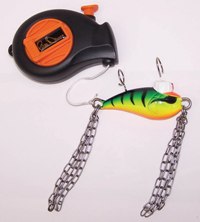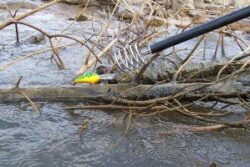Getting snagged is just a part of fishing. Fish tend to congregate around snags, so fishermen take the risk. Lures, flies, jigs, spoons, and plugs are expensive. Just a quality laser/acid sharpened hook can get pricey.
Sometimes we get snagged because of poor casting. Lousy knots may allow rigs to continue on. Old line and drags that are too tight can be line breakers. Poor casting technique can cause rigs to end up lost. Whatever the reason, learn from your mistakes and don’t give up.
When you get snagged, don’t break off the rig right away. Here are some tips to try before kissing your hooks farewell.
Change the angle move up stream/current or down. Now try to jerk the rig off. This works especially well when in a boat.
Pluck the line Crank the line tight and pluck the line like the string on a bow. This will often twitch the rig off. This works especially well with jigs and beadhead flies.
Give it some slack Allow the current to take the line downstream and form a loop. Now set the hook so the line pulls the snagged lure from a downstream angle.
Slide down a dehook lure You can make or buy a sliding dehooker. I have seen these lead sliders look like dogs or fish. You attach them to your line and hold onto them with a cord. It will slide down to the snag and hopefully catch the hooks of your snag. Now jerk the cord and set your rig free. 
Get your buddy to hook you up On small ponds or streams, our fishing buddies are often on the opposite bank. Lower your snagged line so they can cast across it and hook onto it. Have them jerk the line toward their bank to unhook the rig.
Rod tip touch This trick works but be careful. If the snag is close enough for you to wade or touch with the rod, wind the line up and use the rod tip to work the snag free.
Cut a Big Stick Sometimes, thanks to polaroid glasses, you can see the snag. It may be just too deep or far for your rod or reach. Cut a big stick and try to shove it into the snag to free your rig. They also make a coil that can attach to a pole that allows you to wrap up the rig and capture it. 
If you finally have no choice but to break your line, don’t bend the rod to do it. A bent rod and snapped line can injure the fisherman, break the rod, or both. Instead, snug up your drag and pull straight back. Either the rig will break free, the hook may bend, or your line will break. Oh well, tie on a new rig and take another cast. You can’t cry over lost lures.
If you are using a floating plug or lure, look for the lure to surface after you break it off. Occasionally, you may be able to retrieve it.
Once most hooks are wet, it will take just a few weeks until the hooks rust. In a fish’s gut, this happens in just a few days, due to their stomach digestive juices. Sometimes these floaters will show up downstream in a log jam. While you are looking for your lost rigs, you may find others.
Removing old lures, spinners, flies, and hooks along with lost lines are a good idea. Birds and other critters can also be attracted to these lures and get tangled or injured.
Accurate casting and reading the water will prevent most snags. You still need to get close to the cover where the fish are and that can be risky. Polaroid glasses will also allow you to see the snags before you snag them.
Fish smarter and have fun!
Montana Grant